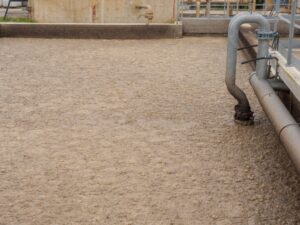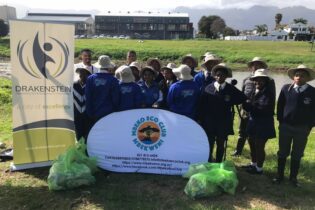Around 7 million people in South Africa use on-sitesanitation with little attention given to the operation and management of these systems. Fortunately, this is changing, and the development of the Faecal Sludge Management Strategy (FSMS) is a step in the right direction.
By Kirsten Kelly The strategy will guide the sector on the safe management of faecal sludge to enhance the operation and maintenance of on-site sanitation systems, prevent contamination of water resources, safeguard public health, and protect the environment from pollution throughout the sanitation service chain. “The Department of Water and Sanitation (DWS) has shifted its focus from just the provision of sanitation facilities to safe management of the entire sanitation service chain,” says Iris Mathye, director: Sanitation, Operational & Capacity Support, DWS. There was encouragement from a global standpoint to create an FSMS. FAECAL SLUDGE: A DEFINITION Faecal sludge is the content that needs to be emptied from on-site sanitation systems such as container-based sanitation solutions, mobile portable toilets, septic tanks, and ventilated improved pit latrines. Faecal sludge is not transported by the sewer network to a point of treatment. It comprises both liquid and solid content in raw or partially digested forms. The UN-Water Global Analysis and Assessment of Sanitation and Drinking Water (GLAAS) 2018/2019 Report gave South Africa two recommendations to improve its sanitation services:1)The management of faecal sludge and beneficiation of both wastewater and faecal sludge should be initiated.
2)The World Health Organization’s sanitation guideline should be fully recognised and integrated into the national agenda.
Furthermore, Sustainable Development Goal (SDG) 6.2 target has been an important guide for the DWS and it clearly calls for sanitation to be safely managed across the sanitation service chain.
Locally, the need for an FSMS is obvious. According to a Statistics South Africa report in 2019, at least 10% (507 732) of households served with on-site sanitation technologies have full pits/containments. When pits are full, there is a high possibility of communities either reverting to open defecation or constructing makeshift pits that are dangerous and do not comply to norms and standards for constructing a sanitation facility. Difficulties with faecal sludge Due to its drier nature, faecal sludge can be difficult to empty from toilets, septic tanks, and pits. Companies that regularly empty toilets have also reported that it can be challenging to appropriately dispose of faecal sludge. Often, wastewater treatment plants reject faecal sludge, as it is difficult to treat together with wastewater. Faecal sludge is very different from wastewater; it is dense and highly concentrated with solids, and can disturb the functionality of wastewater treatment plants. It has been recommended that dedicated faecal sludge treatment plants should be built to support faecal sludge management and the reuse of human waste. Alternatively, existing wastewater treatment plants can be retrofitted with equipment for co-treatment. Furthermore, faecal sludge is classified as hazardous waste and can therefore only be disposed of at a hazardous landfill site. There are only a few of these sites in South Africa, and it is therefore expensive to transport and dispose of faecal sludge at these sites. Very often, faecal sludge is illegally dumped. Mathye adds that pits containing faecal sludge often also contain foreign objects and household waste like shoes, cloths, nappies, and sanitary pads, making it difficult to empty the toilets, reducing storage capacity, shortening the lifespan of the pit latrine, and making it difficult to reuse faecal sludge. “The management of faecal sludge requires new skills. There is limited knowledge around its reuse that requires new skills and a mindset change as people, for instance, can be reluctant to buy food that has been fertilised by faecal sludge. People emptying or treating faecal sludge may be exposed to pathogens, so it is incredibly important to educate them around safety and for them to be fitted with personal protective equipment (PPE).”
Formulation of an FSMS
The DWS collaborated with the USAID Resilient Waters programme (which focuses on the SDG 6 objective of safely managed sanitation) to create the FSMS. “Faecal sludge is still a fairly new concept in the world, and the DWS wanted to learn about faecal sludge management from other countries, and then use our local research and expertise to create a comprehensive strategy. The USAID Resilient Waters programme and Polokwane Municipality had a separate collaboration agreement where sanitation planning tools (developed to guide and assist countries in meeting SDG 6.2) were piloted. These tools included the shit flow diagram, a sanitation safety planning tool, City Service Delivery Assessment, and an options analysis of faecal sludge technologies. Lessons learnt from the pilot project as well as research undertaken by the Water Research Commission and other research institutions were incorporated into the FSMS. It is important that the FSMS is practical and evidence based. The DWS is also working with municipalities to develop a sludge management support programme that requires sludge classification first,” explains Mathye. There have been extensive consultations with the different stakeholders in the business sector as well as different government structures at national and local level, academic institutions, research organisations, civil society, institutions, and toilet innovators. “We had two sets of stakeholders’ consultations; the first time was when we had developed a conceptual framework and the second time was when we developed the draft strategy. The DWS received a lot of guidance from these engagements and has incorporated as much as possible into the FSMS. A steering committee was developed at national level to oversee the development of the strategy and provide inputs and another one in Limpopo (focusing on the Polokwane pilot project). There have been FSMS workshops in the different provinces. The FSMS has now been finalised and is waiting for formal approval from the Minister,” states Mathye. Campaigns and appropriate educational and awareness materials are being developed by the DWS on the safe handling of faecal sludge and dispelling the notion of faecal sludge as a taboo. Best practices“The golden rule when dealing with faecal sludge is planning and considering the entire sanitation service chain: capture, containment, emptying, transport, treatment, safe end-use, and disposal. Before an on-site sanitation system is even placed in an area, it is important to understand the geohydrological conditions in the area in order to choose the appropriate on-site sanitation or non-sewered sanitation system (NSS). The DWS developed a protocol to manage the potential of groundwater contamination from on-site sanitation, which guides the sector on the assessment of the level of risk of the sanitation system to contaminate the groundwater in comparison to other sanitation alternatives and recommend measures to reduce the risks,” explains Lusanda Mfenqa-Agbasi, deputy director: Sanitation Operational Support. Capture and containment: On-site and NSS sanitation systems must be built according to norms and standards and the filling of pits and containers meant for faecal sludge with foreign objects must be avoided.
Emptying: People emptying the sludge must use PPE and receive training to avoid exposure to pathogens and the creation of contaminated spaces.
Transportation: When transporting faecal sludge, there is a risk of an accident or spillages. Therefore, the vacuum trucks or other large vehicles with storage tanks must comply with the Road Traffic Management Act. All vehicles must be appropriately labelled to ensure that should an accident or spillage take place, the correct measures are in place to clean up the faecal sludge. Treatment: The National Environment Management: Waste Act governs the treatment of faecal sludge in order to prevent a negative impact on the environment. The DWS is also investigating options regarding faecal sludge treatment plants and the retrofitting of wastewater treatment plants for the co-treatment of wastewater and faecal sludge. Some African countries already have functioning faecal sludge treatment works and the DWS will learn from them. Beneficial use: The FSMS is encouraging beneficial use of treated faecal sludge. Beneficial end-use refers to the use of treated faecal sludge through various processes to create products that can be used for different
purposes such as soil conditioner, compost, vermicompost, energy/ biogas, or construction materials. The strategy encourages adherence to norms and standards in beneficial use. For example, there are norms and standards for composting developed by the Department of Fisheries, Forestry and the Environment. Safe disposal: The strategy guides on the safe disposal of faecal sludge in South Africa. Safe disposal of faecal sludge that has been emptied from on-site sanitation facilities and decentralised wastewater treatment sytems is a regulated activity and requires authorisation for burial of faecal sludge through deep row entrenchments. The DWS is also updating compulsory norms and standards for water supply and sanitation services, and faecal sludge is included in this document. Some of the regulation regarding faecal sludge involves various departments and the FSMS refers to the different legislation. “It becomes difficult for municipalities to refer to different acts and parts within these acts, so the FSMS beings all the regulations into one document. We are also assisting municipalities in reviewing and developing sanitation related by-laws,” Mathye notes. Future plans
The sanitation service chain brings huge opportunities for businesses and job creation. “There are exciting services and products that can be generated from faecal sludge, like compost, biogas, biofuels, and construction products. The uptake of non-sewered sanitation (NSS) systems will increase over the next few years and we are encouraging inventors to reinvent the toilet. Currently, there are limited assessed NSS technologies being used at a community level. It is important to use NSS technologies that have been tested and piloted to avoid failures when rolled out at a large scale. The DWS believes that NSS can bridge the gap between those communities that are unserved and the infrastructure deficit (ageing infrastructure and infrastructure operating beyond its design capacity). NSS is a safe, dignified, and comfortable solution for all South Africans,” says Andre van der Walt, chief director: Sanitation Services Support, DWS. He adds that by 2030, there will be an estimated 17% deficit between water supply and demand, making NSS a key solution to tackling water availability. “We believe that only sanitation solutions using no to very little water must be utilised in all future developments (government and private). Sanitation is a driver for water security.” With the increased uptake of NSS technologies and on-site systems, it will become increasingly important to manage faecal sludge properly. The FSMS will guide the improved provision of safely managed sanitation along the service chain, while recognising that faecal sludge is a resource, creating a shift to a circular economy.







